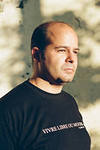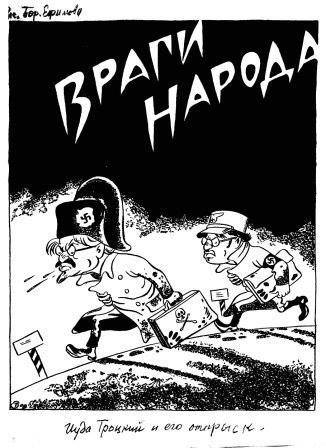Who Is Behind the Trotskyist Conspiracy?
Ilya Budraitskis, a historian, researcher and writer
November 21, 2014
Russian original on OpenLeft.ru/ Translated by TheRussianReader
Speaking at a meeting of his All-Russia People’s Front a couple days ago, Vladimir Putin said, “Trotsky had this [saying]: the movement is everything, the ultimate aim is nothing. We need an ultimate aim.” Eduard Bernstein’s proposition, misquoted and attributed for some reason to Leon Trotsky, is probably the Russian president’s most common rhetorical standby. He has repeated it for many years to audiences of journalists and functionaries while discussing social policy, construction delays at Olympics sites or the dissatisfaction of the so-called creative class. “Democracy is not anarchism and not Trotskyism,” Putin warned almost two years ago.
Putin’s anti-Trotskyist invectives do not depend on the context nor are they influenced by his audience, and much less are they veiled threats to the small political groups in Russia today who claim to be heirs of the Fourth International. Putin’s Trotskyism is of a different kind. Its causes are found not in the present but in the past, buried deep in the political unconscious of the last generation of the Soviet nomenklatura.
The strange myth of the Trotskyist conspiracy, which emerged decades ago, in another age and a different country, has experienced a rebirth throughout Putin’s rule. Sensing, apparently, the president’s personal weakness for “Trotskyism,” obliging media and corrupted experts have turned this Trotskyism into an integral part of the grand propaganda style. Until he died, the indefatigable “Trotskyist” Boris Berezovsky spun his nasty web from London. Until he turned into a conservative patriot, the incendiary “Trotskyist” Eduard Limonov seduced young people with extremism. Camouflaged “Trotskyists” from the Bush and, later, the Obama administrations have continued to sow war and color revolutions. Unmasking “Trotskyists” has become such an important ritual that for good luck, as it were, the famous Dmitry Kiselyov decided to launch a new media resource by invoking it. So what is the history of this conspiracy? And what do Trotskyists have to do with it?
Conspiracy theories are always conservative by nature. They do not offer an alternative assessment of events but, constantly tardy, chase behind them, inscribing them after the fact into their own pessimistic reading of history. Thus, in his Memoirs Illustrating the History of Jacobinism (1797), the Jesuit priest Augustin Barruel, a pioneer of modern conspiracy theory, situated the French Revolution, which had already taken place, in the catastrophic finale of a grand conspiracy of the Knights Templar against the Church and the Capetian dynasty. Masonic conspiracy theories became truly powerful in the late nineteenth century, when the peak of the Masons’ power had already passed. Finally, the idea of a Jewish conspiracy acquired its final shape in The Protocols of the Elders of Zion, fabricated by the tsarist secret police at the turn of the twentieth century, when the power of Jewish finance capital had already been undermined by the rising power of industrial capital. Conspiracy theories have always drawn energy from this distorted link with reality, because the fewer conspirators one could observe in the real world, the more boldly one could endow them with incredible magical powers in the imaginary world.
In keeping with the reactive, belated nature of conspiracy theories, the myth of the Trotskyist conspiracy emerged in the Soviet Union when the Left Opposition, Trotsky’s actual supporters, had long ago been destroyed. Unlike, however, the conspiracies of the past, generated by secret agents and mad men of letters, the foundations of the Trotskyist conspiracy were tidily laid by NKVD investigators. The distorting mirror logic of the Great Terror dictated that, although the “Trotskyists” skillfully concealed themselves, and any person could prove to be one, the conspiracy must necessarily be exposed. An unwritten law of Stalinist socialism was that the truth will out, and this, of course, deprived the conspiracy theory of its telltale aura of mystery.
After Stalin’s death, when the Purges were a thing of the past, and Soviet society had begun to become inhibited and conservative, the conspiracy myth took on more familiar features. The stagnation period, with its general apathy, distrust, and societal depression, was an ideal breeding ground for the conspiracy theory. No one had seen any live Trotskyists long ago, and it was seemingly silly to denounce them, but everyone was well informed about the dangers of Trotskyism.
To read the whole article, visit TheRussianReader.


